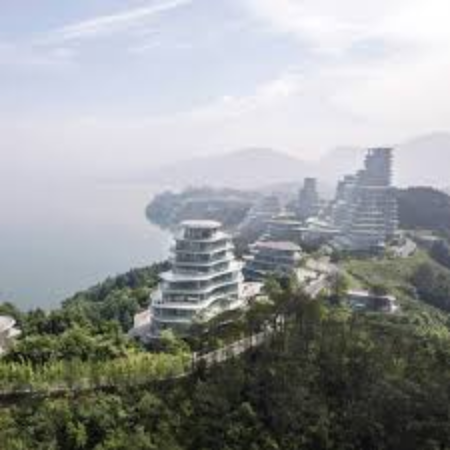
I can help you with that. Here is an article about Huangshan National Forest Park with the structure you requested:
Huangshan National Forest Park: A Natural Wonder
Nestled in eastern China, Huangshan National Forest Park is a UNESCO World Heritage site renowned for its breathtaking scenery, diverse ecosystems, and rich cultural heritage. The park spans over 1,600 square kilometers and is home to a variety of attractions that captivate visitors from around the globe.
Natural Splendor of Huangshan Mountain Village
Huangshan Mountain Village embodies a harmonious blend of architecture and nature. Its structures flow seamlessly into the environment, offering continuous and tranquil retreats that embrace the surrounding landscapes.
Architectural Integration with Nature:
- Horizontal Expansion and Dissolution: The village's design prioritizes a horizontal layout, allowing the buildings to span and dissolve into the natural surroundings, minimizing their visual impact and creating a sense of organic integration.
- Views of Tea Fields: Apartments offer picturesque views of the nearby tea fields, connecting residents with the region's agricultural heritage and the beauty of cultivated landscapes.
- Expansive Balconies: Each apartment features an expansive balcony designed to maximize the panoramic vistas. Glass railings ensure unobstructed views, while floor-to-ceiling glazing further enhances the connection with nature.
- Topographic Sensitivity: The village's architecture hugs the mountain's topography, respecting the natural contours and minimizing environmental disruption. Buildings seem to emerge organically from the slopes, blending seamlessly into the landscape.
Iconic Peaks and Granite Formations
Huangshan, meaning "Yellow Mountain," is aptly named for its 72 towering peaks, often shrouded in mist and appearing as if they were painted. These granite formations, sculpted by millennia of erosion, are a testament to nature's artistic prowess.
- Lotus Peak (1864.8 m): The highest peak in Huangshan, offering awe-inspiring panoramic views.
- Bright Summit Peak (1840 m): Famous for its breathtaking sunrises and stunning cloud formations.
- Celestial Capital Peak (1829.2 m): Known for its unique rock formations and proximity to several historic sites.
| Peak Name | Altitude (meters) | Notable Features |
|---|---|---|
| Lotus Peak | 1864.8 | Highest peak, panoramic views |
| Bright Summit Peak | 1840 | Breathtaking sunrises, stunning cloud formations |
| Celestial Capital Peak | 1829.2 | Unique rock formations, historic sites |
Ancient Pines and Diverse Flora
Huangshan is home to over 1,500 plant species, including the iconic Huangshan pine (Pinus hwangshanensis). These resilient trees, clinging precariously to cliffs and rock faces, have become a symbol of the region's enduring beauty.
- Huangshan Pine (Pinus hwangshanensis): Endemic to the region, known for its unique shapes and resilience.
- Flowering Plants: Rhododendrons, azaleas, and camellias add vibrant bursts of color, particularly during spring and summer.
- Medicinal Herbs: The park boasts a rich diversity of medicinal plants, reflecting its historical significance in traditional Chinese medicine.
Hot Springs and Waterfalls
Water, in all its forms, plays a crucial role in shaping Huangshan's landscape. Hot springs offer relaxation and rejuvenation, while cascading waterfalls create dramatic natural spectacles.
- Purple Cloud Peak Hot Springs: Known for their therapeutic properties, believed to alleviate fatigue and promote circulation.
- Nine Dragons Waterfall: One of the tallest waterfalls in Huangshan, cascading down a series of granite cliffs.
- Hundred-zhang Waterfall: Named for its impressive 100-meter drop, creating a thunderous roar.
Cultural Heritage
Beyond its natural wonders, Huangshan is steeped in cultural significance, having inspired artists, poets, and philosophers for centuries.
- Buddhist and Taoist Temples: Historic temples nestled amidst the peaks offer insights into China's spiritual heritage.
- Ancient Stone Carvings: Inscriptions and carvings on cliffs and rocks throughout the park provide glimpses into the region's history and artistic traditions.
Frequently Asked Questions:
Q1: What is the best time to visit Huangshan National Forest Park?
A1: Spring and autumn offer the most pleasant weather for hiking and sightseeing. Spring brings vibrant blooms, while autumn showcases stunning foliage.
Q2: How do I get to Huangshan National Forest Park?
A2: The park is accessible by bus or car from nearby cities such as Huangshan City and Hangzhou. There is also a cable car available for those who prefer not to hike to the top.
Q3: Are there accommodation options within Huangshan National Forest Park?
A3: Yes, there are hotels and guesthouses located within the park, offering stunning views and easy access to trails and attractions. However, it's recommended to book in advance, especially during peak season.